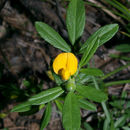ar
الأسماء في صفحات التنقل


The pencil flower, Stylosanthes biflora, is a perennial herbaceous plant in the pea/legume family (Fabaceae).Native to the southeastern United States, its wide distribution covers from Texas east to Florida and the Atlantic seabord, north to southern Illinois and New York state.It grows in upland rocky woodlands, bluffs, upland savannas, sandstone glades, prairies, and fields, and can also thrive in disturbed areas and nutrient-poor soils.
A small herbaceous plant, the wiry, branched stem of pencil flower grows from a taproot, sometimes reaching 18 inches tall. Its leaves are tripartite (have three leaflets).The plant grows erect or lying down, preferring sunny and dry locations. Shiny leaf veins and the shape of its stipules (the small leaves that grow out on either side of a stem node) can be used to distinguish it from other similar legume species.The stipules have a pointy “beak” shape; for this reason S. biflora is sometimes called the end-beaked or side-beaked pencil flower. The name pencil flower refers to the way the flower sepals make a hollow tube around the pistil, like the wood sheath around the lead of a pencil.
Pencil flower blooms between late spring and late summer.Usually the small (0.25 inch/0.75cm across) bright yellow-orange flowers grow singly in a cluster of leaves at the top of the stem, but sometimes several flowers occur in a small bunch. Either way, few flowers bloom at one time.The flowers have the characteristic legume shape, and are bee pollinated. Each flower produces a pod that contains one seed. The leaf beetle Sumitrosis ancoroides and caterpillars of the barred sulfur butterfly (Eurema daira) use pencil flower as a host plant, and many adult insects visit the flowers for nectar.Ungulates (horses, deer, cows) readily eat the palatable and nutritious S. biflora foliage.Wild turkey and bobwhite quail eat the seeds.
Cherokee populations used pencil flower root to make a concoction as a gynecological aid, “used for female complaint” and to promote menstruation.In the 1900s it was known as afterbirth weed.
Across the broad range of this species pencil flower shows variation in the erectness and hairiness of its stems, and the number of flowers it produces in a bunch.Some have argued that these variations indicate that S. biflora is a species complex.
(Hamel and Chiltoskey 1975; Henkel 1906; Hilty 2015; Kurz 1999; Mohlenbrock 1958; Williamson 2015)
Stylosanthes biflora, known by the common names pencil flower,[1] sidebeak pencilflower,[2] and endbeak pencilflower,[3] is a species of flowering plant in the Fabaceae (legume) family. It is native to the Southeastern United States where it is widespread in open areas of native vegetation. It produces yellow-orange flowers in the summer and fall.
This species is highly variable throughout its range, and numerous species had previously been segregated out of it. However, their morphological differences have been found to be so overlapping that the former segregates are now considered the same species.[4]
S. biflora is a branching perennial that grows 10–30 cm (4–12 in) tall. The stems are wiry, round, hairy, and light to medium green. Each compound leaf has three leaflets (trifoliate) and are alternate on the stems. The leaflets measure 1–4 cm (0.5–1.5 in) long and are elliptic in shape. They have smooth margins. A pair of partly joined bracts, or stipules, tapering to a beak, surrounds the base of each petiole and part of the adjacent stem.[5]
The flowers are orange to yellow and are similar to others in the pea family. The petals consist of large standard top) petal and smaller wings and keel, subtended by bracts.[6][7] The flowers are nearly circular in shape.[8]
The species is native in the United States from Texas to the west, Illinois to the north, New York to the east, and Florida to the south. It is also present in Arizona.[1] Its habitats include sunny and dry areas, such as glades, prairies, savannas, dry upland forests, tops of bluffs, and riverbanks.[6]
The flowers bloom May to September and are visited by bees and butterflies. It is a host plant for the barred yellow butterfly (Eurema daira).[9]
Stylosanthes biflora, known by the common names pencil flower, sidebeak pencilflower, and endbeak pencilflower, is a species of flowering plant in the Fabaceae (legume) family. It is native to the Southeastern United States where it is widespread in open areas of native vegetation. It produces yellow-orange flowers in the summer and fall.
This species is highly variable throughout its range, and numerous species had previously been segregated out of it. However, their morphological differences have been found to be so overlapping that the former segregates are now considered the same species.
Stylosanthes biflora là một loài thực vật có hoa trong họ Đậu. Loài này được (L.) Britton & al. miêu tả khoa học đầu tiên.[1]
Stylosanthes biflora là một loài thực vật có hoa trong họ Đậu. Loài này được (L.) Britton & al. miêu tả khoa học đầu tiên.